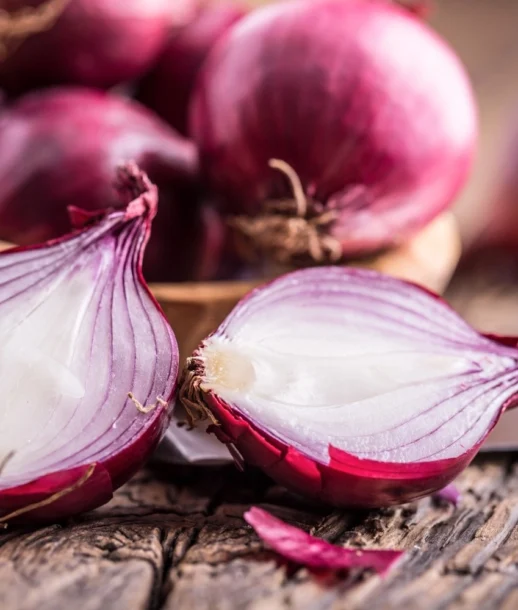Allium cepa, also known as onion, is a bulbous perennial herb in the Amaryllida ceae family. It is the most widely cultivated species of the genus Allium, and is native to Central Asia. Onions are grown and used throughout the world, and are an essential ingredient in many cuisines. Allium cepa contains a number of bioactive compounds, including quercetin, anthocyanins, and thiosulfinates. These compounds have been shown to have a variety of health benefits, including:
- Antibacterial activity
- Anti-inflammatory activity
- Antioxidant activity
- Anticancer activity
- Blood sugar regulation
- Heart health
- Brain health
Allium cepa is also a good source of dietary fiber, vitamins C and K, and minerals such as potassium, phosphorus, and magnesium. The extract of Allium cepa is used in traditional medicine to treat a variety of conditions, including:
- Colds and flu
- Coughs and congestion
- High blood pressure
- Heart disease
- Cancer
- Diabetes
- Alzheimer’s disease
More research is needed to fully understand the health benefits of Allium cepa. However, the available evidence suggests that it is a healthy food that can be beneficial for overall health.
Here are some additional details about the health benefits of Allium cepa:
- Antibacterial activity: Onion extract has been shown to kill a variety of bac teria, including E. coli, Streptococcus pneumoniae, and Pseudomonas aerugi nosa. This may be due to the presence of quercetin and other antioxidants in onions.
- Anti-inflammatory activity: Onion extract has been shown to reduce inflam mation in the body. This may be due to the presence of quercetin and other flavonoids.
- Antioxidant activity: Onions are a good source of antioxidants, which can help protect the body from damage caused by free radicals.
- Anticancer activity: Onion extract has been shown to have anti-cancer prop erties in animal studies. However, more research is needed to confirm these findings in humans.
- Blood sugar regulation: Onions may help to regulate blood sugar levels. This may be due to the presence of quercetin and other compounds that can improve insulin sensitivity.
- Heart health: Onions may help to improve heart health by lowering choles terol levels and reducing inflammation.
- Brain health: Onions may help to improve brain health by reducing the risk of Alzheimer’s disease and other neurodegenerative disorders.
Botanical Description :
- Plant: Allium cepa is a herbaceous plant, meaning it lacks woody tissue and typically dies back to the ground at the end of the growing season.
- Bulb: The onion plant is characterized by its underground bulb, which serves as a storage organ for nutrients. The bulb is composed of tightly packed, fleshy, concentric layers.
- Leaves: The leaves of Allium cepa are long, slender, and hollow. They arise from the basal plate of the bulb and are arranged in a rosette. The leaves can vary in color from green to bluish-green, depending on the variety.
- Inflorescence: If left to mature, Allium cepa will produce a flowering stem that can reach up to 1-1.5 meters in height. The inflorescence is a spherical cluster of small, star-shaped flowers, typically white or pale pink in color.
- Flowers: Each flower of Allium cepa has six tepals (petals and sepals that are similar in appearance) arranged in two whorls. The reproductive structures (stamens and pistil) are located at the center of the flower.
- Fruit: The fruit of Allium cepa is a capsule containing small, black seeds.
- Root System: The primary root system of Allium cepa is fibrous, originating from the base of the bulb. It serves mainly for anchorage and absorp tion of water and nutrients.
Chemical constituents of Allium cepa (onion):
- Flavonoids: Quercetin, kaempferol, and fisetin are the most abundant fla vonoids in onions. These compounds have antioxidant and anti-inflamma tory properties.
- Sulfur compounds: Allicin, diallyl disulfide, and diallyl trisulfide are sulfur compounds that are produced when onions are chopped or crushed. These compounds have antibacterial, antifungal, and antioxidant proper ties.
- Other compounds: Onions also contain vitamins C and K, dietary fiber, and minerals such as potassium, phosphorus, and magnesium.
The exact composition of the chemical constituents in onions can vary depend ing on the variety of onion, the growing conditions, and the way the onion is pro cessed. However, the overall health benefits of onions are thought to be due to the combination of these different compounds.
Extraction Dosage –
▪ 450 to 500 mg

